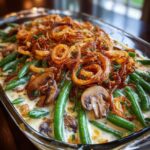Crispy Kataifi Nests with Spinach and Feta Filling Recipe: A Mediterranean Delight
These crispy kataifi nests with spinach and feta filling bring Mediterranean flavors to your table with minimal effort. The golden, shredded phyllo exterior gives way to a creamy, savory center that balances earthy spinach with tangy cheese. Whether serving as an appetizer or light main course, this dish delivers impressive texture contrast and visual appeal.
Traditional Greek cuisine inspires this recipe, which transforms simple ingredients into an elegant presentation. The kataifi dough bakes into delicate strands that shatter with each bite, while the filling stays luxuriously soft. Furthermore, the combination of fresh herbs and briny feta creates layers of flavor that develop as you eat. For best results, serve these nests warm when the cheese filling reaches its perfect gooey consistency.
Quick Recipe Highlights
- Flavor Profile: The crispy kataifi nests with spinach and feta filling offer a perfect balance of salty, tangy, and earthy notes. Fresh dill and lemon zest brighten the rich cheese filling.
- Texture: Expect shatteringly crisp exteriors giving way to creamy, molten centers. The kataifi strands create hundreds of delicate crispy layers.
- Aroma: As these bake, your kitchen will fill with the buttery scent of phyllo and the herbal fragrance of wilted spinach and dill.
- Visual Appeal: The golden nests resemble edible bird nests with their shredded dough appearance. The vibrant green filling peeking through adds contrast.
- Skill Level Needed: While not difficult, working with kataifi dough requires some finesse. Beginners may need practice shaping the nests.
- Special Equipment: You’ll need a muffin tin for shaping and a pastry brush for butter application. No other specialty tools required.
Recipe Overview
- Difficulty Level: This recipe earns its intermediate rating from the handling of delicate kataifi dough. However, the steps remain straightforward with proper guidance. With practice, even novice cooks can master the technique.
- Category: These versatile nests work equally well as appetizers, side dishes, or light vegetarian mains. They fit brunch, lunch, or dinner menus with ease.
- Cuisine: Rooted in Greek culinary traditions, this dish showcases classic Mediterranean ingredients. The preparation method reflects authentic techniques adapted for home kitchens.
- Cost: Using frozen spinach and readily available cheeses keeps costs moderate. Kataifi dough represents the only specialty ingredient, often found in international markets.
- Season: While delicious year-round, these nests particularly shine in spring and summer when fresh herbs abound. They make excellent additions to seasonal entertaining menus.
- Occasion: Perfect for dinner parties, holiday gatherings, or bridal showers. The individual portions create elegant plating opportunities for special events.
Why You’ll Love This Recipe
The crispy kataifi nests with spinach and feta filling deliver restaurant-quality presentation with homemade simplicity. First, the contrast between the crunchy exterior and soft center creates irresistible texture play. Additionally, the flavors develop beautifully as the ingredients meld during baking. Unlike many appetizers, these hold well at room temperature without losing their appealing crispness.
From a practical standpoint, these nests offer make-ahead convenience. You can prepare the filling a day in advance and assemble just before baking. Moreover, the recipe scales easily for larger gatherings without compromising quality. The individual portions also help with portion control and elegant serving.
Nutritionally, this dish packs valuable nutrients from the spinach and quality protein from the cheeses. Importantly, the recipe uses butter judiciously, allowing the natural flavors to shine. Compared to fried alternatives, these baked nests offer lighter indulgence without sacrificing satisfaction.
Entertaining becomes effortless with these crowd-pleasing nests. Their uniform size ensures consistent cooking, while the eye-catching presentation sparks conversation. Furthermore, the vegetarian-friendly option accommodates diverse dietary preferences at gatherings. Guests often request the recipe after tasting these flavorful bites.
Cost-conscious cooks appreciate how premium these taste despite modest ingredients. Kataifi dough stretches far, and the filling components remain affordable. When seasonal spinach prices drop, this becomes an economical way to impress guests. The recipe also minimizes food waste by using common pantry staples.
Historical Background and Cultural Significance
Kataifi dough traces its origins to the Ottoman Empire’s vast culinary traditions. Bakers developed this unique shredded phyllo as a variation on traditional sheets. Over centuries, Greek and Turkish cuisines perfected techniques for working with the delicate strands. Today, kataifi features prominently in both sweet and savory preparations across the Mediterranean.
In Greek cuisine, spinach and feta combinations hold cultural significance dating to ancient times. The classic spanakopita inspired this modern interpretation using kataifi instead of phyllo sheets. Traditional village cooks often used wild greens and local cheeses in similar preparations. This recipe honors those roots while adapting the technique for contemporary kitchens.
The evolution of kataifi recipes reflects changing kitchen technologies. Originally baked in wood-fired ovens, modern versions adapt to conventional home appliances. While traditionalists might shape the dough by hand, using muffin tins ensures consistent results for today’s cooks. The essence of the dish remains faithful to its heritage despite these practical updates.
Regional variations abound throughout the Mediterranean. Some versions incorporate herbs like mint or oregano, while others add pine nuts for texture. Coastal areas might include seafood in the filling, while inland versions stick to vegetarian combinations. This spinach and feta iteration represents a beloved classic that crosses regional boundaries.
Ingredient Deep Dive
Kataifi dough forms the foundation of this recipe’s signature texture. Also called shredded phyllo, this product consists of thin strands of dough that bake up incredibly crisp. Look for it frozen in Middle Eastern or Mediterranean markets. Thaw overnight in the refrigerator before using, and keep covered to prevent drying. If unavailable, you can create a similar effect by finely shredding phyllo sheets with a knife.
Fresh spinach contributes vibrant color and earthy flavor to the filling. Always choose crisp, deep green leaves without yellowing. Baby spinach works particularly well for its tenderness. Thoroughly wash and dry the leaves to prevent watery filling. Frozen spinach makes an acceptable substitute when drained and squeezed very dry. Nutritionally, spinach provides iron, vitamin K, and antioxidants.
Quality feta cheese makes all the difference in this recipe. Authentic Greek feta, made from sheep’s milk or a sheep-goat blend, offers the best flavor and texture. The cheese should crumble easily but not feel dry. Avoid pre-crumbled varieties which often contain anti-caking agents. For storage, keep feta submerged in its brine in the refrigerator for up to two weeks.
Common Mistakes to Avoid
- Overhandling the kataifi dough leads to tough nests. Gently separate the strands without compacting them.
- Insufficiently draining the spinach creates soggy filling. Press out all excess moisture using a clean kitchen towel.
- Skipping the butter brushing results in pale, dry nests. Generously coat each layer for golden crispness.
- Overfilling the nests causes spillage during baking. Leave adequate space for the filling to expand slightly.
- Using cold filling makes shaping difficult. Bring the mixture to room temperature before assembling.
- Baking at too low a temperature yields greasy nests rather than crisp ones. Verify your oven calibration.
- Neglecting to rotate the pan creates uneven browning. Turn halfway through for consistent color.
- Serving immediately from the oven risks burned mouths. Let nests rest 5 minutes for ideal eating temperature.
Essential Techniques
Proper kataifi handling ensures the signature crisp texture. First, thaw the dough completely but keep it chilled until use. When separating strands, work quickly to prevent drying. Lightly butter each layer as you build the nests, which promotes flakiness. Importantly, avoid packing the dough too tightly – the airy structure creates lightness.
Filling preparation requires attention to moisture control. After wilting the spinach, squeeze out every drop of liquid using a clean towel. When combining ingredients, mix gently to maintain the feta’s crumbly texture. Season judiciously, remembering that feta brings its own saltiness. For best results, chill the filling briefly to firm it up before shaping.
Pro Tips for Perfect Crispy Kataifi Nests
- Chill your hands when shaping nests to prevent butter from melting prematurely.
- Use a small ice cream scoop for evenly portioned filling distribution.
- Brush the muffin tin thoroughly with butter to ensure easy release after baking.
- For extra crispness, lightly toast the kataifi in a dry pan before shaping.
- Add a pinch of nutmeg to the filling for depth that complements the spinach.
- Garnish with lemon zest just before serving to brighten all the flavors.
Variations and Adaptations
Regional variations might include chopped artichokes or sun-dried tomatoes in the filling. For a Turkish twist, add minced lamb or beef to create meat-filled nests. Some Greek island versions incorporate seafood like shrimp or crab for luxurious occasions. Vegetarians can boost protein by mixing in cooked lentils or chickpeas.
Seasonal adaptations allow year-round enjoyment. Spring versions might feature fresh peas and mint, while autumn could showcase roasted squash. Winter holidays invite additions of chestnuts or cranberries for festive flair. Summer brings opportunities to use farmers’ market greens like Swiss chard or beet tops.
Serving and Presentation Guide
For elegant plating, arrange the nests on a bed of peppery arugula leaves. Drizzle with high-quality olive oil just before serving for sheen and flavor. Consider adding edible flowers like nasturtiums for special occasions. Serve with lemon wedges to allow guests to adjust acidity to taste.
Traditional accompaniments include tzatziki sauce for dipping or a simple Greek salad. For heartier meals, pair with grilled meats or fish. As part of a meze spread, combine with dolmades, hummus, and warm pita bread. Brunch service pairs beautifully with poached eggs and fresh fruit.
Wine and Beverage Pairing
A crisp Assyrtiko from Santorini makes an ideal Greek wine pairing. Its mineral notes and acidity cut through the richness beautifully. Alternatively, choose a Sauvignon Blanc with herbal characteristics that echo the dill in the filling. For red lovers, a light-bodied Pinot Noir won’t overwhelm the delicate flavors.
Non-alcoholic options include sparkling water with lemon or mint-infused iced tea. Greek coffee makes a traditional after-dinner companion. For brunch service, freshly squeezed orange juice or a blood Mary cocktail complement the savory nests wonderfully.
Storage and Shelf Life
Baked nests keep well at room temperature for up to four hours without losing crispness. For longer storage, refrigerate in an airtight container up to two days. Reheat in a 350°F oven for 5-7 minutes to restore texture. Avoid microwaving which makes the kataifi soggy.
Unbaked assembled nests freeze beautifully for up to one month. Arrange on a parchment-lined sheet pan to freeze solid before transferring to bags. Bake directly from frozen, adding 3-5 minutes to the cooking time. The filling can be prepared and refrigerated separately up to three days in advance.
Nutritional Deep Dive
Each nest provides approximately 180 calories with 12g of quality fats from olive oil and cheese. The spinach contributes fiber, vitamin A, and iron, while the dairy offers calcium and protein. Using part-skim feta reduces saturated fat without sacrificing flavor. For lower carb counts, reduce the kataifi portion slightly.
The glycemic load remains moderate, making these suitable for many eating plans. Vegetarians gain complete proteins from the egg and cheese combination. To boost nutrition further, consider adding chia seeds or wheat germ to the filling mixture. Always account for individual dietary needs and restrictions.
Dietary Adaptations
For gluten-free versions, substitute shredded gluten-free phyllo or rice noodles. Dairy-free adaptations can use tofu feta and vegan butter alternatives. Keto followers might replace the kataifi with shredded zucchini tossed in almond flour. Always check labels on packaged ingredients for hidden allergens when accommodating special diets.
Frequently Asked Questions
Can I make these nests ahead of time? Yes, you can assemble the unbaked nests up to one day in advance. Keep refrigerated until ready to bake. Alternatively, freeze for longer storage as described above.
What if I can’t find kataifi dough? Shredded phyllo makes the best substitute. Alternatively, create nests using very thin vermicelli rice noodles soaked briefly in warm water.
How do I prevent soggy bottoms? Ensure proper spinach draining and bake on the oven’s middle rack. Placing the muffin tin on a preheated baking sheet helps too.
Can I use other cheeses? While feta is traditional, ricotta or goat cheese blends work well. Avoid overly moist cheeses that could make the filling watery.
Are these served hot or cold? These taste best warm, when the cheese becomes delightfully creamy. Room temperature works for buffets, but avoid serving chilled.
How do I transport these for parties? Use a rigid container with parchment between layers. Reheat briefly at the venue if possible.
Can I make mini versions? Absolutely! Use a mini muffin tin and reduce baking time by 3-5 minutes for bite-sized appetizers.
Why did my nests fall apart? This usually indicates insufficient butter between kataifi layers or overhandling the dough. Handle gently and butter generously.
How do I know when they’re done? The nests should turn deep golden brown all over. The filling will bubble slightly at the edges when ready.
Can I air fry these? Yes! Cook at 375°F for 8-10 minutes. Work in batches and don’t overcrowd the basket.
Crispy Kataifi Nest with Melted Spinach & Feta Core
5 Stars 4 Stars 3 Stars 2 Stars 1 Star
No reviews
- Author: Chef Billy
Description
A crispy golden nest made of kataifi pastry, filled with a warm, melted spinach and feta center.
Ingredients
For the Crust:
- 200g kataifi pastry (shredded phyllo dough)
- 100g unsalted butter, melted
- 200g fresh spinach, chopped
- 150g feta cheese, crumbled
- 1 small onion, finely diced
- 1 clove garlic, minced
- 1 tbsp olive oil
- 1/2 tsp dried oregano
- Salt and pepper to taste
Instructions
1. Prepare the Crust:
- Preheat oven to 375°F (190°C). Lightly grease a muffin tin.
- In a pan, heat olive oil over medium heat. Sauté onion and garlic until soft. Add spinach and cook until wilted. Season with oregano, salt, and pepper. Remove from heat and mix in crumbled feta.
- Separate kataifi pastry into strands. Brush with melted butter and press into muffin tin cups to form nests.
- Bake for 10 minutes until lightly golden. Remove from oven and press centers down gently with a spoon.
- Fill each nest with the spinach and feta mixture. Return to oven and bake for another 10-15 minutes until crispy and golden.
- Let cool slightly before removing from the tin. Serve warm.
Notes
You can customize the seasonings to taste.
I’m Billy, a classically trained culinary school graduate from The Culinary Institute of America with over 12 years in the restaurant industry and over 19 years of cooking experience.







